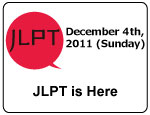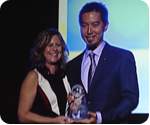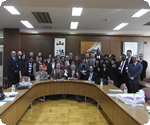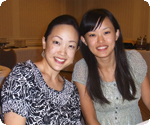


The arrival of December means that it is time for the Japanese-language proficiency test. This is one of this biggest programs organized by the Japan Foundation, Los Angeles, which occurs annually on the first Sunday in December. Over three thousand Japanese-language learners in the United States and over four hundred thousand worldwide will challenge the JLPT for various reasons to determine their level of Japanese proficiency. To all the dedicated learners who are busy preparing for this test, we wish you the best of luck on December 4th. We are also working on a surprise for the end of the year and hope you will visit our website on the last week of December to find out about the secret project we have been preparing for our users. Finally, I want to wish all our readers a safe and happy holiday season.
Misako Ito, Director

We will be organizing the 2011 JLPT at 11 cities across the United States including Atlanta, Boston, Chicago, Fayetteville (AR), Honolulu, Los Angeles, New York, Philadelphia, San Francisco, Seattle, and Washington DC. Please travel safe if you are coming from afar and leave early to account for any delays. We look forward to seeing you on Sunday.

With over a month left for registration, The Japan Foundation, Los Angeles, is still accepting applications for the JF Nihongo Courses. We will be offering four classes in this inaugural course, which will focus on the four topics of Mastering Japanese Kana, Japanese for Everyday Use, Business in Japanese, and Action! in Japanese (Performing in Japanese). Classes are filling up fast so please register soon if you are interested in learning Japanese.
For more information, please visit Courses.

From November 18th-20th, we hosted a booth at the 2011 ACTFL Conference at the Colorado Convention Center in Denver. Like previous years, we also conducted the second part of the leadership workshop. The biggest news this year was that Yo Azama was named the 2012 National Language Teacher of the year. Azama sensei has been teaching at all levels at North Salinas High School in Northern California. He has also worked in various capacities with the Japan Foundation, most recently as a guest speaker at the 2011 J-LEAP Orientation. We are very proud of this very distinguished achievement, which further solidifies Japanese-language education in the United States and wish him continued success during his career.
To view Yo Azama's acceptance speech, please visit http://vimeo.com/32921319.

On Saturday, November 5th, 2011, we co-organized the United States Martial Arts Festival at the Redondo Beach Performing Arts Center. To promote Japanese culture in Southern California, we invited Dr. David Matsumoto, Mr. Robert Matsueda, and Dr. Denis Gainty to discuss the importance of Martial Arts today. We also showcased other traditional Japanese art forms in the lobby such as SADO (Japanese Tea Ceremony), KADO (Japanese flower arrangement), and SHODO (Japanese calligraphy) performed respectively by Omotosenke, Sogetsu, and the United States Shodo Association. Overall, the attendees were very satisfied with this event and thought it was very interesting and well organized.

The 2011 Group-Tour Program took place from November 6th to November 13th, 2011. A total of 27 participants including five from Canada was part of this seven day education exchange tour. During their time in Japan, the participants made courtesy calls to the Ministry of Education, Culture, Sports, Science and Technology as well as the Ministry of Foreign Affairs. They also visited the Japan Foundation Head Office and the Japanese Language Institute, Urawa. The highlight of the trip for the North American Educators was the school visits to Saitama Municipal Urawa High School and Kashiwagi Elementary School where they got to experience the Japanese education system first hand. This is always an eye opening experience for the participants as they are able to participate in exchanges with the local students and teachers. Towards the end of the tour, the educators had an opportunity to experience Japanese culture first hand to complete the Japan experience. We would like to thank this year's participants for another successful tour and look forward to hearing about their experience in a future issue of Breeze.

This month, we have invited Megumi Katayama, a teaching assistant at Kennedy High School in Cedar Rapids, Iowa, and Sayoko Minami, a teaching assistant at Niu Valley Middle School in Honolulu, Hawaii, to share their experiences at American high schools. As you may recall, we sent 15 Japanese teaching assistants to assist Japanese-language teachers at select high schools all over the country. Each month, two participants will report on their experiences.

Hello my name is Megumi Katayama and I came from Shiretoko, Hokkaido, to the Midwestern United States in IOWA. It is my first time to live where there is no ocean and no mountains. I could not imagine that I could live without it but I am living with a very huge blue sky and clear air now!
I work at Kennedy High School in Cedar Rapids, Iowa, as a Japanese Teaching Assistant with my supervisor Dan Carolin sensei, who teaches Japanese and is the Co-Chair of the world language department.
I assist in teaching five different levels of Japanese class. It is two Japanese 1, one Japanese 2, two Japanese 3s, one Japanese 4 and Advanced Placement at the high school. It culminates in a 4th year Advanced Placement course aimed at preparing the students to succeed in the AP Exam for Japanese Language and Culture.
In Cedar Rapids, there are three high schools with Japanese programs. One of the programs is Kennedy High School and the other two are Washington High School (taught by Julie Cain sensei) and Jefferson High School (taught by Rachel Henkelmann sensei). In order to better meet the needs of the students, they have been working on restructuring our curriculum, basing it on a series of thematic units rather than following a more conventional textbook-centered approach. We meet two times a month to continue to write the new curriculum and to develop materials to support the lessons. In addition, we meet to develop assessments that we share and later compare the results. I am honored to be able to participate in these meetings.
I have been visiting the three high schools for a week at a time. Each school has a distinct style and characteristic so I am enjoying the different teaching styles and students. My teaching partners are smart and funny. I am very lucky to join and spend time with them. They always give me great ideas and hints for amazing teaching plans. Also they provide me with many chances to teach and plan the classes as the only native Japanese speaker.
I am already getting great experiences from my teaching partners and students and hope that they are also benefiting from my contributions. I want to be able to share with them many things about Japanese language and Japanese culture not only classic but also modern.
This month has “Christmas” and next month has “Oshogatsu” so I have a chance to teach my students about Japanese events including culture. I hope to it will be a great experience for them.
 Sayoko Minami (Niu Valley Middle School, HI)
Sayoko Minami (Niu Valley Middle School, HI)Hi, I'm Sayoko Minami from the Kamehameha kingdom. I am fortunately working as a Japanese teacher in Niu Valley Middle School under the shining sun in Hawaii . I teach students ranging from 6th to 8th graders. My school has a distinction of being Hawaii’s first and only public middle school authorized by IB (an International Baccalaureate) to deliver the Middle Year Programme. So, everyone has a right to learn a language. In my school, we have 2 languages which are Chinese and Japanese. About 70 percent of the students take Japanese. The main reason is because students “believe” Japanese is much easier than Chinese. Beside, many students are also part Japanese, so they are eager to know more about themselves by learning the Japanese language.
I have more than 350 students and I meet with each class twice a week. So I was very confused to remember 350 different names in just a few months (I almost remember them now, but not all). Because this is Hawaii, some students come to class playing Ukuleles, and some have very tanned skin because they are always out surfing, boogie boarding, etc. I am learning more about the people of Hawaii through my students.
In class, I usually support the students who need help, grade homework and late assignments, and I make class room materials such as flash cards and games. After school, some students who have difficulty catching up in class or need extra help come to me for tutoring. It is precious time for me to spend with them after school because I can communicate with them face to face, which I don't have the time to do during regular class time.
What surprised me the most since arriving in Hawaii is the students’ family names. More than 35 percentage of each class has Japanese last names such Kato, Hisatake, and so on. That makes me feel like I am living and teaching in Japan. I did not realize that there was such a strong connection between Hawaii and Japan and some aspects of Japan got mixed up on the way here (ex: spam rice balls are called nigiri and you can buy it in 7-Eleven!). Hawaiians unconsciously exhibit Japanese characteristics even though they are not even aware of it. I believe this can be a strong teaching point in Japanese class because my students have lots of opportunities to experience Japanese around them and I want to use this situation to benefit and motivate them to be more interested in Japanese language and culture!
 New Books and Library Closure for the Month of December
New Books and Library Closure for the Month of DecemberThis month, we have five new books in the Nihongo Library, which are listed below.
Kukai on the Philosophy of Language
Translated and Annotated by Shingen Takagi and Thomas Eijo Dreitlein
Remote Control
Kotaro Isaka, Translated by Stephen Snyder
Writing the Love of Boys: Origins of Bishonen Culture in Modernist Japanese Literature
Jeffrey Angles
Forest of Eyes: Selected Poems of Tada Chimako
Translated from the Japanese and with an Introduction and Notes by Jeffrey Angles
Transforming Japan: How Feminism and Diversity are making a difference
Edited by Kumiko Fujimura-Fanselow
Please note that the Nihongo Library will be closed for two weeks at the end of the month from December 23rd, 2011 to January 3rd, 2012 for inventory and the holidays. We will reopen on Wednesday, January 4th, 2012. If the due date on your books is during this period, please make sure to contact us beforehand.

This is the fourth part of an eight part series that will highlight the experiences of 32 participants of the 2011 JET Memorial Invitational Program. Through this program, participants travelled to Japan in July of 2011 for a 10 day exchange that focused on Japanese language and culture with the purpose of fostering friendship and goodwill between the youth of both countries. This month, we will be featuring the essays of Anastasia Clegg, Aingeal Miller, Samuel Rigsby, and Rachel Deter.

The 20th National Japan Bowl will be held on April 12th and 13th, 2012 at the National 4-H Center near Washington DC. If a team applies before the early bird registration deadline, December 2nd, the $55 registration fee for the teacher will be waived. The final deadline for registration is January 20, 2012. The National Japan Bowl costs $55 per student and $60 per team which includes registration for the competition, three meals at the 4-H Center, a Japan Bowl T-shirt and other goodies.

The Japan Foundation, Los Angeles, is a proud supporter of Rune Boutiques World Debut Party at Royal/T in Culver City. To celebrate the Roots of Kawaii in Japanese pop culture, this event will feature a fashion show by 6%DOKIDOKI, original artwork by Rune Naito, fashion contest, live performance by Kyary Pamyu Pamyu, pop-up store, and autograph/photo session. After the debut event, the exhibition and pop-up store will remain for one month until January 9th, 2012.
Dates/Times/Locations: Friday, December 9th, 8PM-12Midnight, Royal/T 8910 Washington Blvd., Culver City, CA 90232